M AN687
Precision Temperature-Sensing With RTD Circuits
Author:
Bonnie C. Baker
Microchip Technology Inc.
INTRODUCTION
The most widely measured phenomena in the process
control environment is temperature. Common ele-
ments, such as Resistance Temperature Detectors
(RTDs), thermistors, thermocouples or diodes are used
to sense absolute temperatures, as well as changes in
temperature. For an overview and comparison of these
sensors, refer to Microchip’s AN679, “Temperature-
Sensing Technologies”, DS00679.
Of these technologies, the platinum RTD temperature-
sensing element is the most accurate and stable over
time and temperature. RTD element technologies are
constantly improving, further enhancing the quality of
the temperature measurement (see Figure 1). Typi-
cally, a data acquisition system conditions the analog
signal from the RTD sensor, making the analog
translation of the temperature usable in the digital
domain.
This application note focuses on circuit solutions that
use platinum RTDs in their design. Initially, the RTD
temperature-sensing element will be compared to the
negative temperature coefficient (NTC) thermistor,
which is also a resistive temperature-sensing element.
In this forum, the linearity of the RTD will be presented
along with calibration formulas that can be used to
improve the off-the-shelf linearity of the element. For
additional information concerning the thermistor tem-
perature sensor, refer to Microchip’s AN685, “Ther-
mistors
in Single Supply Temperature Sensing
Circuits”, DS00685. Finally, the signal-conditioning
path
the RTD system will be covered with
application circuits from sensor to microcontroller.
for
Precision Current Source <1 mA
VOUT
RTD, most popular element
is made using platinum,
typically 100Ω @ 0°C
FIGURE 1: Unlike thermistors, RTD
temperature-sensing elements require current
excitation.
RTD OVERVIEW
The acronym “RTD” is derived from the term “Resis-
tance Temperature Detector”. The most stable, linear
and repeatable RTD is made of platinum metal. The
temperature coefficient of the RTD element is positive.
This is in contrast to the NTC thermistor, which has a
negative temperature coefficient, as is shown graphi-
cally in Figure 2. An approximation of the platinum RTD
resistance change over temperature can be calculated
by using the constant 0.00385Ω/Ω/°C. This constant is
easily used to calculate the absolute resistance of the
RTD at temperature.
EQUATION
RTD T(
0.00385Ω Ω⁄
°C⁄
=
)
RTD0 T RTD0
+
×
×
where:
RTD(T) is the resistance value of the RTD element at
temperature (Celsius),
RTD0 is the specified resistance of the RTD element
at 0°C and,
T is the temperature environment that the RTD is
placed (Celsius).
2003 Microchip Technology Inc.
DS00687B-page 1
�
AN687
100
10
1
0.1
0.01
0.001
)
Ω
(
e
c
n
a
t
s
s
e
R
i
Thermistor
RTD
0.0001
-100 50
0
50
100 150 200 250 300
Temperature (°C)
The temperature vs. resis-
FIGURE 2:
tance characteristics of the RTD sensing element
is considerably different than the thermistor sen-
sor element. The RTD sensing element has a
positive temperature coefficient and is
considerably more linear.
The RTD element resistance is extremely low when
compared to the resistance of a NTC thermistor
element, which ranges up to 1 MΩ at 25°C. Typical
specified 0°C values for RTDs are 50, 100, 200, 500,
1000 or 2000Ω. Of these options, the 100Ω platinum
RTD is the most stable over time and linear over
temperature.
If the RTD element is excited with a current reference
at a level that does not create an error due to self-heat-
ing, the accuracy can be ±4.3°C over its entire temper-
ature range of -200°C to 800°C. If a higher accuracy
temperature measurement is required, the linearity for-
mula below (Calendar-Van Dusen Equation) can be
used in a calculation in the controller engine or be used
to generate a look-up table.
RTD T(
+
where:
RTD(T) is the resistance of the RTD element at tem-
perature,
RTD0 is the specified resistance of the RTD element
at 0°C,
T is the temperature that is applied to the RTD ele-
ment (Celsius) and,
A, B, and C are constants derived from resistance
measurements at 0°C, 100°C and 260°C.
RTD0 1 AT BT2
100CT3 CT4
)
=
+
–
+
The linearity performance of a typical RTD is shown in
Figure 3.
)
C
°
±
(
r
o
r
r
E
e
r
u
t
a
r
e
p
m
e
T
5
4.5
4
3.5
3
2.5
2
1.5
1
0.5
0
-200-100 0 100 200 300 400 500 600 700 800
Temperature (°C)
The linearity error of the
FIGURE 3:
platinum RTD temperature sensor is small when
compared to other sensors, such as the
thermocouple and thermistor.
The RTD element requires a current excitation. If the
magnitude of the current source is too high, the element
will dissipate power and start to self-heat. Consequently,
care should be taken to insure that ≤ 1 mA of current is
used to excite the RTD element.
The advantages and disadvantages of the RTD
temperature sensing element
in
Table 1.
is summarized
TABLE 1:
RTD TEMPERATURE SENSING
ELEMENT ADVANTAGES AND
DISADVANTAGES
Advantages
Disadvantages
Very Accurate and Stable Expensive Solution
Fairly Linear to ±4%°C
Requires Current
Excitation
Danger of Self-Heating
Low Resistive Element
Good Repeatability
RTD CURRENT EXCITATION CIRCUIT
For best linearity, the RTD sensing element requires a
stable current reference for excitation. This can be
implemented in a number of ways, one of which is
shown in Figure 4. In this circuit, a voltage reference,
along with two operational amplifiers, are used to
generate a floating 1 mA current source.
DS00687B-page 2
2003 Microchip Technology Inc.
�
R2
+
−
1 mA
RREF = 2.5 kΩ
1/2
−
MCP602
+
A2
RW
RW
RW
R1
1/2
−
MCP602
+
A1
R3
R4
VREF
=2.5V
R1=R2=R3=R4=25kΩ
A current source for the RTD
FIGURE 4:
element can be constructed in a single-supply
environment from two operational amplifiers and
a precision voltage reference.
This is accomplished by applying a 2.5V precision volt-
age reference to R4 of the circuit. Since R4 is equal to
R3, and the non-inverting input to A1 is high-imped-
ance, the voltage drop across these two resistors is
equal. The voltage between R3 and R4 is applied to the
non-inverting input of A1. That voltage is gained by
(1 + R2/R1) to the output of the amplifier and the top of
the reference resistor, RREF. If R1 = R2, the voltage at
the output of A1 is equal to:
)
+(
1 R2/R1
(
×
2
–
(
×
VREF VR4
EQUATION
=
VOUTA1
=
VOUTA1
where:
VOUTA1 is the voltage at the output of A1 and
VR4 is the voltage drop across R4.
VREF VR4
)
–
)
The voltage at the output of A2 is equal to:
EQUATION
VOUTA1
=
VREF VR4
–
–
VR3
This same voltage appears at the inverting input of A2
and across to the non-inverting input of A2.
AN687
Solving these equations, the voltage drop across the
reference resistor, RREF, is equal to:
(
–
–
=
=
=
VREF VR4
VOUTA1 VOUTA2
×
)
(
2
–
VREF
EQUATION
VRREF
VRREF
VRREF
where:
VRREF is the voltage across the reference resistor,
RREF and,
VR3 is the voltage drop across R3
VREF VR4
VR3
–
–
)
The current through RREF is equal to:
EQUATION
IRTD
=
VREF / RREF
This circuit generates a current source that is ratio met-
ric to the voltage reference. The same voltage refer-
ence can be used in other portions of the circuit, such
as the analog-to-digital (A/D) converter reference.
Absolute errors in the circuit will occur as a consequence
of the absolute voltage of the reference, the initial offset
voltages of the operational amplifiers, the output swing
of A1, mismatches between the resistors, the absolute
resistance value of RREF and the RTD element. Errors
due to temperature changes in the circuit will occur as a
consequence of the temperature drift of the same ele-
ments listed above. The primary error sources over tem-
perature are the voltage reference, offset drift of the
operational amplifiers and the RTD element.
RTD SIGNAL-CONDITIONING PATH
Changes in resistance of the RTD element over tem-
perature are usually digitized through an A/D conver-
sion, as shown in Figure 5. The current excitation
circuit, shown in Figure 4, is used to excite the RTD
element. With this style of excitation, the magnitude of
the current source can be tuned to 1 mA or less by
adjusting RREF. The voltage drop across the RTD ele-
ment is sensed by A3, then gained and filtered by A4.
With this circuit, a 3-wire RTD element is selected.
This configuration minimizes errors due to wire
resistance and wire resistance drift over temperature.
2003 Microchip Technology Inc.
DS00687B-page 3
�
AN687
R
A1
1/4
−
MCP602
+
R
Current
Generator
Circuit
1 mA
RREF = 2.5 kΩ
VREF = 2.5V
1/4
A2
−
MCP602
+
R1=100 kΩ
R
R
R2 = 100 kΩ
1/4
A3
−
MCP604
+
R3
R4
C4
R5
C3
1/4
A4
+
MCP604
−
R6
RW1
RW2
RW2
VIN
,
)
D
T
R
0
0
1
T
P
C
°
0
@
Ω
0
0
1
(
8
0
5
C
2
1
C
P
I
VREF
+IN
–IN
VSS
MCP3201
FIGURE 5:
This circuit uses a RTD temperature-sensitive element to measure temperatures from
-200°C to 600°C. The current generator circuit from Figure 4 excites the sensor. An operational amplifier
(A3) is used to zero wire resistance error. A fourth amplifier (A4) is used to gain the signal and filter possible
alias interference. A 12-bit converter (MCP3201) converts the voltage across the RTD to digital code for the
8-pin controller (PIC12C508).
DS00687B-page 4
2003 Microchip Technology Inc.
�
AN687
Technologies”,
“Temperature Sensing
REFERENCES
AN679,
DS00679, Baker, Bonnie, Microchip Technology Inc.
“Practical Temperature Measurements”, OMEGA
CATALOG, pg Z-11
AN684, “Single-Supply Temperature Sensing with
Thermocouples”, DS00684, Baker, Bonnie, Microchip
Technology Inc.
AN682, “Using Operational Amplifiers for Analog Gain
in Embedded System Design”, DS00682, Baker, Bon-
nie, Microchip Technology Inc.
AN685, “Thermistors in Single-Supply Temperature-
Sensing Circuits”, DS00685, Baker, Bonnie, Microchip
Technology Inc.
“Evaluating Thin Film RTD Stability”, SENSORS, Hyde,
Darrell, OCT. 1997, pg 79
“Refresher on Resistance Temperature Devices”,
Madden, J.R., SENSORS, Sept., 1997, pg 66
“Producing Higher Accuracy From SPRTs (Standard
Platinum Resistance Thermometer)”, MEASUREMENT
& CONTROL, Li, Xumo, June, 1996, pg118
In this circuit, the RTD element equals 100Ω at 0°C. If
the RTD is used to sense temperature over its entire
range of -200°C to 600°C, the range of resistance pro-
duced by the RTD would be nominally 23Ω to 331Ω.
Since the resistance range is relatively low, wire resis-
tance and wire resistance change over temperature can
skew the measurement of the RTD element. Conse-
quently, a 3-wire RTD device is used to reduce these
errors.
The errors contributed by the wire resistances, RW1
and RW3, are subtracted from the circuit with A3, the
operational amplifier circuit. In this configuration, R1
and R2 are equal and are relatively high. The value of
R3 is selected to ensure that the leakage currents
through the resistor do not introduce errors to the cur-
rent in the RTD element. The transfer function of this
portion of the circuit is:
(
)
VIN Vw1
–
) 1 R2/ R1
+(
) VIN R2/R1
–
EQUATION
(
VOUTA3
=
where:
VIN = VW1+VRTD+VW3,
VWx is the voltage drop across the wires to and from
the RTD and
VOUTA3 is the voltage at the output of A3.
If it is assumed that
R1 = R2 and RW1 = RW3
the transfer function above reduces to:
VOUTA3 = VRTD
The voltage signal at the output of A3 is filtered with a
2nd order, low pass filter created with A4, R3, C3, R4 and
C4. This same signal is also gained by the resistors R5
and R6.
CONCLUSION
Although the RTD requires more circuitry in the signal-
conditioning path than the thermistor or the silicon tem-
perature sensor, it ultimately provides a high-precision,
relatively linear result over a wider temperature range.
If further linearization is performed in the controller, the
RTD circuit can achieve ±0.01°C accuracy.
2003 Microchip Technology Inc.
DS00687B-page 5
�
AN687
NOTES:
DS00687B-page 6
2003 Microchip Technology Inc.
�
Note the following details of the code protection feature on Microchip devices:
•
Microchip products meet the specification contained in their particular Microchip Data Sheet.
•
•
•
•
Microchip believes that its family of products is one of the most secure families of its kind on the market today, when used in the
intended manner and under normal conditions.
There are dishonest and possibly illegal methods used to breach the code protection feature. All of these methods, to our
knowledge, require using the Microchip products in a manner outside the operating specifications contained in Microchip's Data
Sheets. Most likely, the person doing so is engaged in theft of intellectual property.
Microchip is willing to work with the customer who is concerned about the integrity of their code.
Neither Microchip nor any other semiconductor manufacturer can guarantee the security of their code. Code protection does not
mean that we are guaranteeing the product as “unbreakable.”
Code protection is constantly evolving. We at Microchip are committed to continuously improving the code protection features of our
products. Attempts to break microchip’s code protection feature may be a violation of the Digital Millennium Copyright Act. If such acts
allow unauthorized access to your software or other copyrighted work, you may have a right to sue for relief under that Act.
Information contained in this publication regarding device
applications and the like is intended through suggestion only
and may be superseded by updates. It is your responsibility to
ensure that your application meets with your specifications.
No representation or warranty is given and no liability is
assumed by Microchip Technology Incorporated with respect
to the accuracy or use of such information, or infringement of
patents or other intellectual property rights arising from such
use or otherwise. Use of Microchip’s products as critical
components in life support systems is not authorized except
with express written approval by Microchip. No licenses are
conveyed, implicitly or otherwise, under any intellectual
property rights.
Trademarks
The Microchip name and logo, the Microchip logo, dsPIC,
KEELOQ, MPLAB, PIC, PICmicro, PICSTART, PRO MATE and
PowerSmart are registered trademarks of Microchip
Technology Incorporated in the U.S.A. and other countries.
FilterLab, microID, MXDEV, MXLAB, PICMASTER, SEEVAL
and The Embedded Control Solutions Company are
registered trademarks of Microchip Technology Incorporated
in the U.S.A.
Accuron, Application Maestro, dsPICDEM, dsPICDEM.net,
ECONOMONITOR, FanSense, FlexROM, fuzzyLAB, In-
Circuit Serial Programming, ICSP, ICEPIC, microPort,
Migratable Memory, MPASM, MPLIB, MPLINK, MPSIM,
PICC, PICkit, PICDEM, PICDEM.net, PowerCal, PowerInfo,
PowerMate, PowerTool, rfLAB, rfPIC, Select Mode,
SmartSensor, SmartShunt, SmartTel and Total Endurance are
trademarks of Microchip Technology Incorporated in the
U.S.A. and other countries.
Serialized Quick Turn Programming (SQTP) is a service mark
of Microchip Technology Incorporated in the U.S.A.
All other trademarks mentioned herein are property of their
respective companies.
© 2003, Microchip Technology Incorporated, Printed in the
U.S.A., All Rights Reserved.
Printed on recycled paper.
Microchip received QS-9000 quality system
certification for its worldwide headquarters,
design and wafer fabrication facilities in
Chandler and Tempe, Arizona in July 1999
and Mountain View, California in March 2002.
The Company’s quality system processes and
procedures are QS-9000 compliant for its
PICmicro® 8-bit MCUs, KEELOQ® code hopping
devices, Serial EEPROMs, microperipherals,
non-volatile memory and analog products. In
addition, Microchip’s quality system for the
design and manufacture of development
systems is ISO 9001 certified.
2003 Microchip Technology Inc.
DS00687B-page 7
�
M
WORLDWIDE SALES AND SERVICE
AMERICAS
Corporate Office
2355 West Chandler Blvd.
Chandler, AZ 85224-6199
Tel: 480-792-7200 Fax: 480-792-7277
Technical Support: 480-792-7627
Web Address: http://www.microchip.com
Atlanta
3780 Mansell Road, Suite 130
Alpharetta, GA 30022
Tel: 770-640-0034 Fax: 770-640-0307
Boston
2 Lan Drive, Suite 120
Westford, MA 01886
Tel: 978-692-3848 Fax: 978-692-3821
Chicago
333 Pierce Road, Suite 180
Itasca, IL 60143
Tel: 630-285-0071 Fax: 630-285-0075
Dallas
4570 Westgrove Drive, Suite 160
Addison, TX 75001
Tel: 972-818-7423 Fax: 972-818-2924
Detroit
Tri-Atria Office Building
32255 Northwestern Highway, Suite 190
Farmington Hills, MI 48334
Tel: 248-538-2250 Fax: 248-538-2260
Kokomo
2767 S. Albright Road
Kokomo, IN 46902
Tel: 765-864-8360 Fax: 765-864-8387
Los Angeles
18201 Von Karman, Suite 1090
Irvine, CA 92612
Tel: 949-263-1888 Fax: 949-263-1338
Phoenix
2355 West Chandler Blvd.
Chandler, AZ 85224-6199
Tel: 480-792-7966 Fax: 480-792-4338
San Jose
Microchip Technology Inc.
2107 North First Street, Suite 590
San Jose, CA 95131
Tel: 408-436-7950 Fax: 408-436-7955
Toronto
6285 Northam Drive, Suite 108
Mississauga, Ontario L4V 1X5, Canada
Tel: 905-673-0699 Fax: 905-673-6509
ASIA/PACIFIC
Australia
Microchip Technology Australia Pty Ltd
Marketing Support Division
Suite 22, 41 Rawson Street
Epping 2121, NSW
Australia
Tel: 61-2-9868-6733 Fax: 61-2-9868-6755
China - Beijing
Microchip Technology Consulting (Shanghai)
Co., Ltd., Beijing Liaison Office
Unit 915
Bei Hai Wan Tai Bldg.
No. 6 Chaoyangmen Beidajie
Beijing, 100027, No. China
Tel: 86-10-85282100 Fax: 86-10-85282104
China - Chengdu
Microchip Technology Consulting (Shanghai)
Co., Ltd., Chengdu Liaison Office
Rm. 2401-2402, 24th Floor,
Ming Xing Financial Tower
No. 88 TIDU Street
Chengdu 610016, China
Tel: 86-28-86766200 Fax: 86-28-86766599
China - Fuzhou
Microchip Technology Consulting (Shanghai)
Co., Ltd., Fuzhou Liaison Office
Unit 28F, World Trade Plaza
No. 71 Wusi Road
Fuzhou 350001, China
Tel: 86-591-7503506 Fax: 86-591-7503521
China - Hong Kong SAR
Microchip Technology Hongkong Ltd.
Unit 901-6, Tower 2, Metroplaza
223 Hing Fong Road
Kwai Fong, N.T., Hong Kong
Tel: 852-2401-1200 Fax: 852-2401-3431
China - Shanghai
Microchip Technology Consulting (Shanghai)
Co., Ltd.
Room 701, Bldg. B
Far East International Plaza
No. 317 Xian Xia Road
Shanghai, 200051
Tel: 86-21-6275-5700 Fax: 86-21-6275-5060
China - Shenzhen
Microchip Technology Consulting (Shanghai)
Co., Ltd., Shenzhen Liaison Office
Rm. 1812, 18/F, Building A, United Plaza
No. 5022 Binhe Road, Futian District
Shenzhen 518033, China
Tel: 86-755-82901380 Fax: 86-755-8295-1393
China - Qingdao
Rm. B505A, Fullhope Plaza,
No. 12 Hong Kong Central Rd.
Qingdao 266071, China
Tel: 86-532-5027355 Fax: 86-532-5027205
India
Microchip Technology Inc.
India Liaison Office
Marketing Support Division
Divyasree Chambers
1 Floor, Wing A (A3/A4)
No. 11, O’Shaugnessey Road
Bangalore, 560 025, India
Tel: 91-80-2290061 Fax: 91-80-2290062
Japan
Microchip Technology Japan K.K.
Benex S-1 6F
3-18-20, Shinyokohama
Kohoku-Ku, Yokohama-shi
Kanagawa, 222-0033, Japan
Tel: 81-45-471- 6166 Fax: 81-45-471-6122
Korea
Microchip Technology Korea
168-1, Youngbo Bldg. 3 Floor
Samsung-Dong, Kangnam-Ku
Seoul, Korea 135-882
Tel: 82-2-554-7200 Fax: 82-2-558-5934
Singapore
Microchip Technology Singapore Pte Ltd.
200 Middle Road
#07-02 Prime Centre
Singapore, 188980
Tel: 65-6334-8870 Fax: 65-6334-8850
Taiwan
Microchip Technology (Barbados) Inc.,
Taiwan Branch
11F-3, No. 207
Tung Hua North Road
Taipei, 105, Taiwan
Tel: 886-2-2717-7175 Fax: 886-2-2545-0139
EUROPE
Austria
Microchip Technology Austria GmbH
Durisolstrasse 2
A-4600 Wels
Austria
Tel: 43-7242-2244-399
Fax: 43-7242-2244-393
Denmark
Microchip Technology Nordic ApS
Regus Business Centre
Lautrup hoj 1-3
Ballerup DK-2750 Denmark
Tel: 45-4420-9895 Fax: 45-4420-9910
France
Microchip Technology SARL
Parc d’Activite du Moulin de Massy
43 Rue du Saule Trapu
Batiment A - ler Etage
91300 Massy, France
Tel: 33-1-69-53-63-20 Fax: 33-1-69-30-90-79
Germany
Microchip Technology GmbH
Steinheilstrasse 10
D-85737 Ismaning, Germany
Tel: 49-89-627-144-0
Fax: 49-89-627-144-44
Italy
Microchip Technology SRL
Via Quasimodo, 12
20025 Legnano (MI)
Milan, Italy
Tel: 39-0331-742611 Fax: 39-0331-466781
United Kingdom
Microchip Ltd.
505 Eskdale Road
Winnersh Triangle
Wokingham
Berkshire, England RG41 5TU
Tel: 44-118-921-5869 Fax: 44-118-921-5820
05/30/03
DS00687B-page 8
2003 Microchip Technology Inc.
�
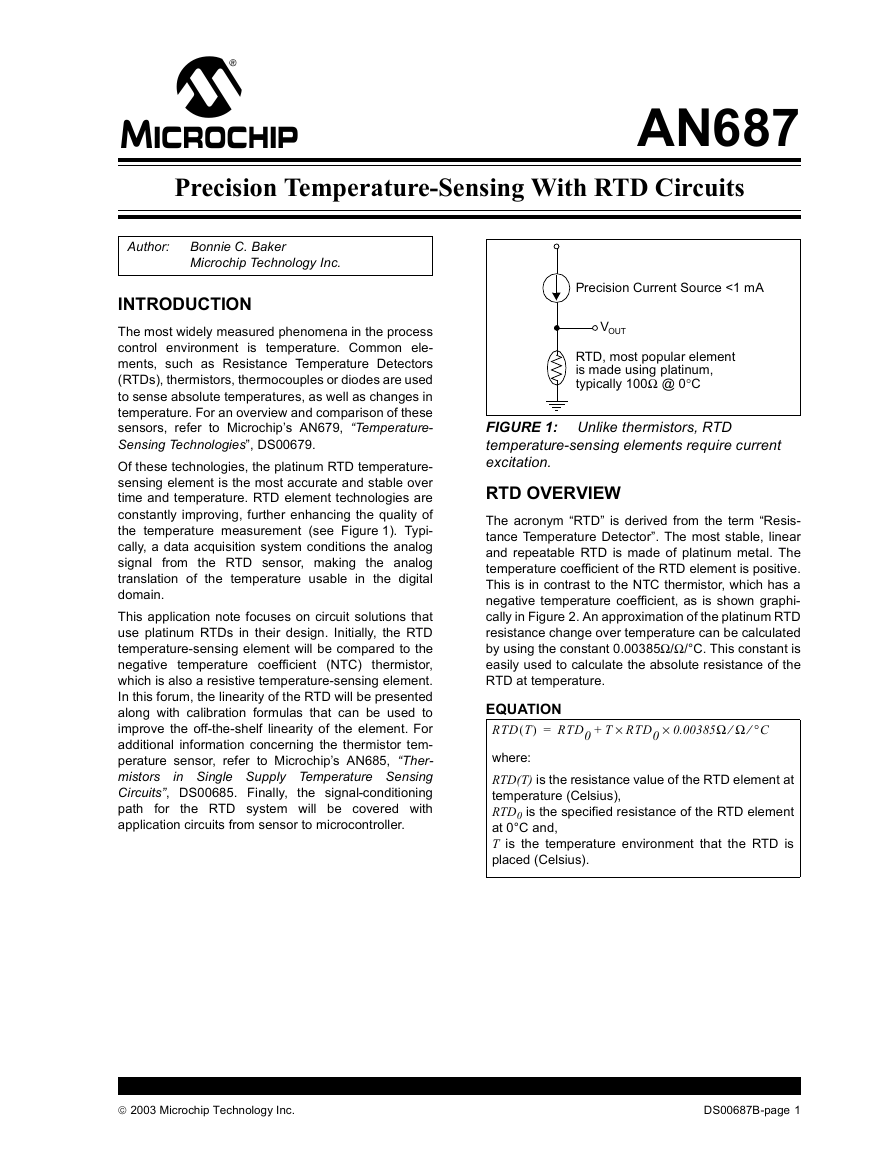
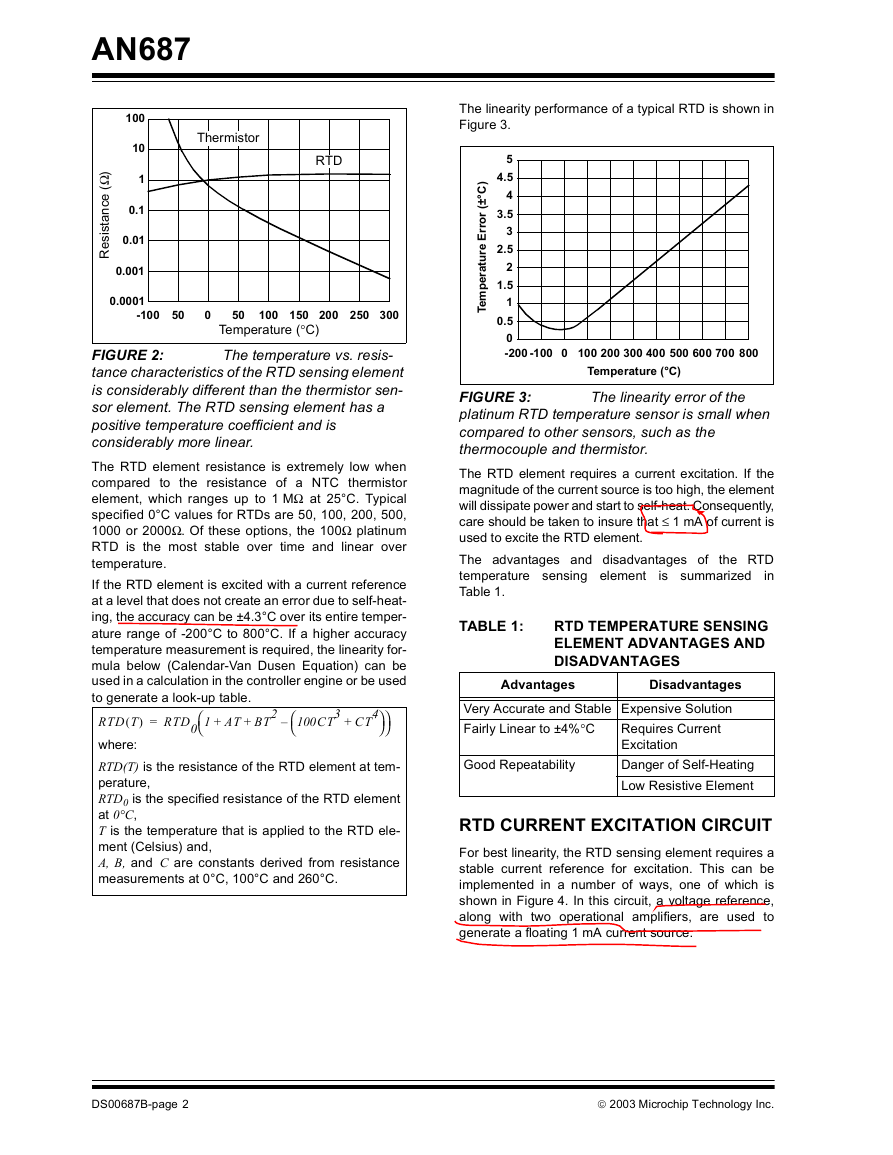
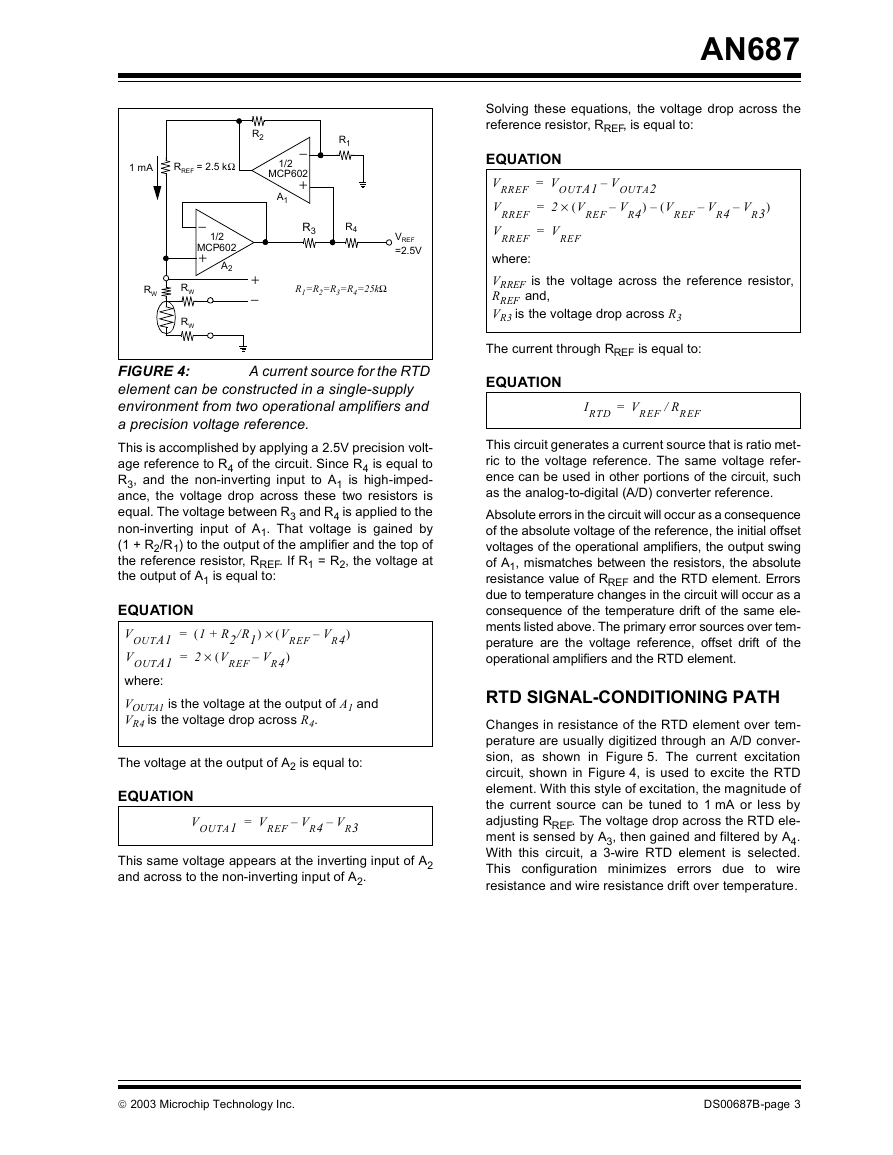

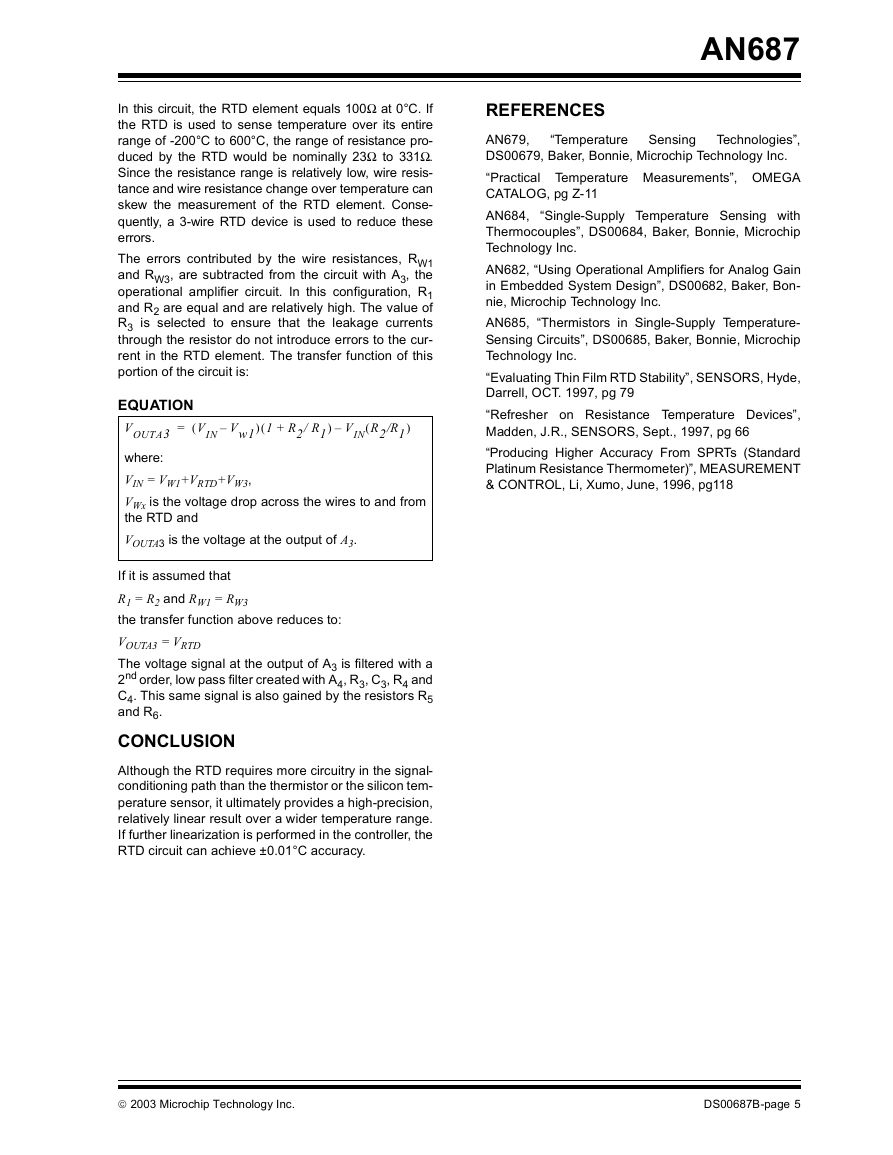
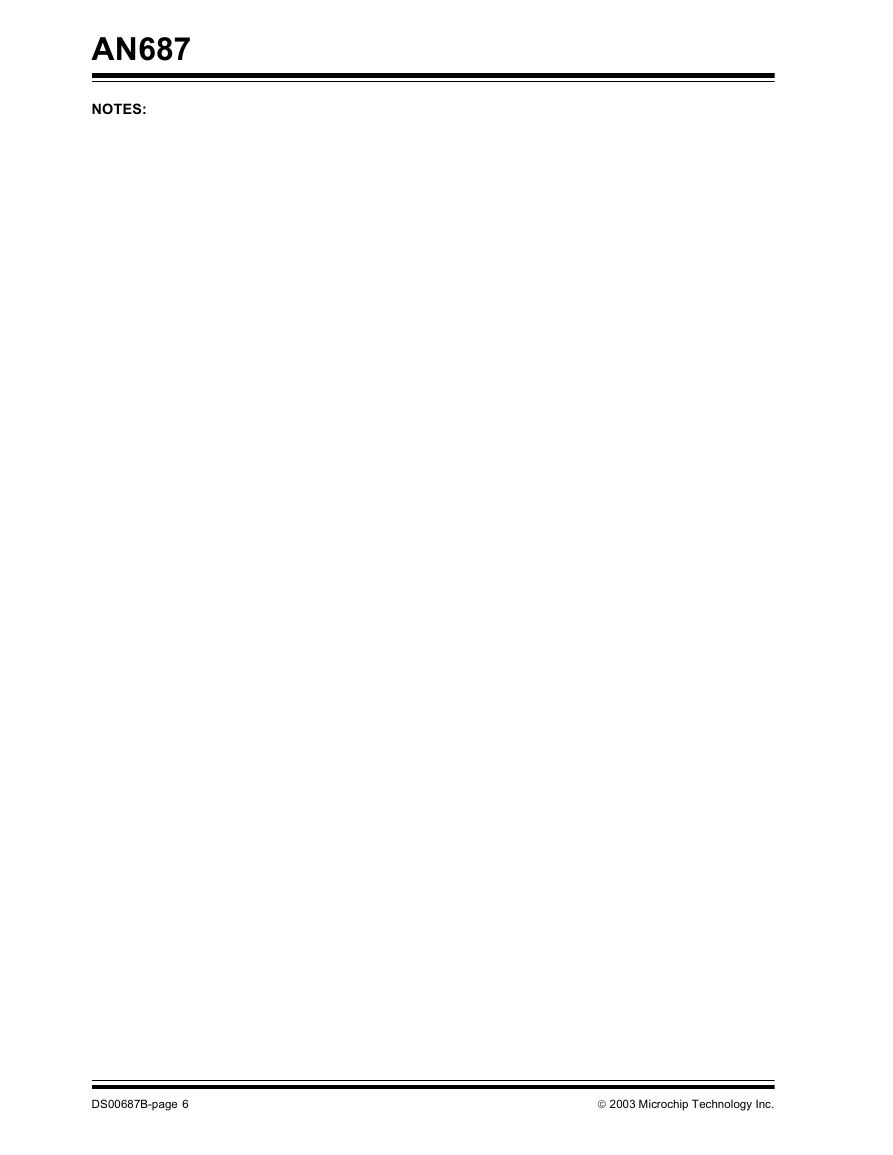
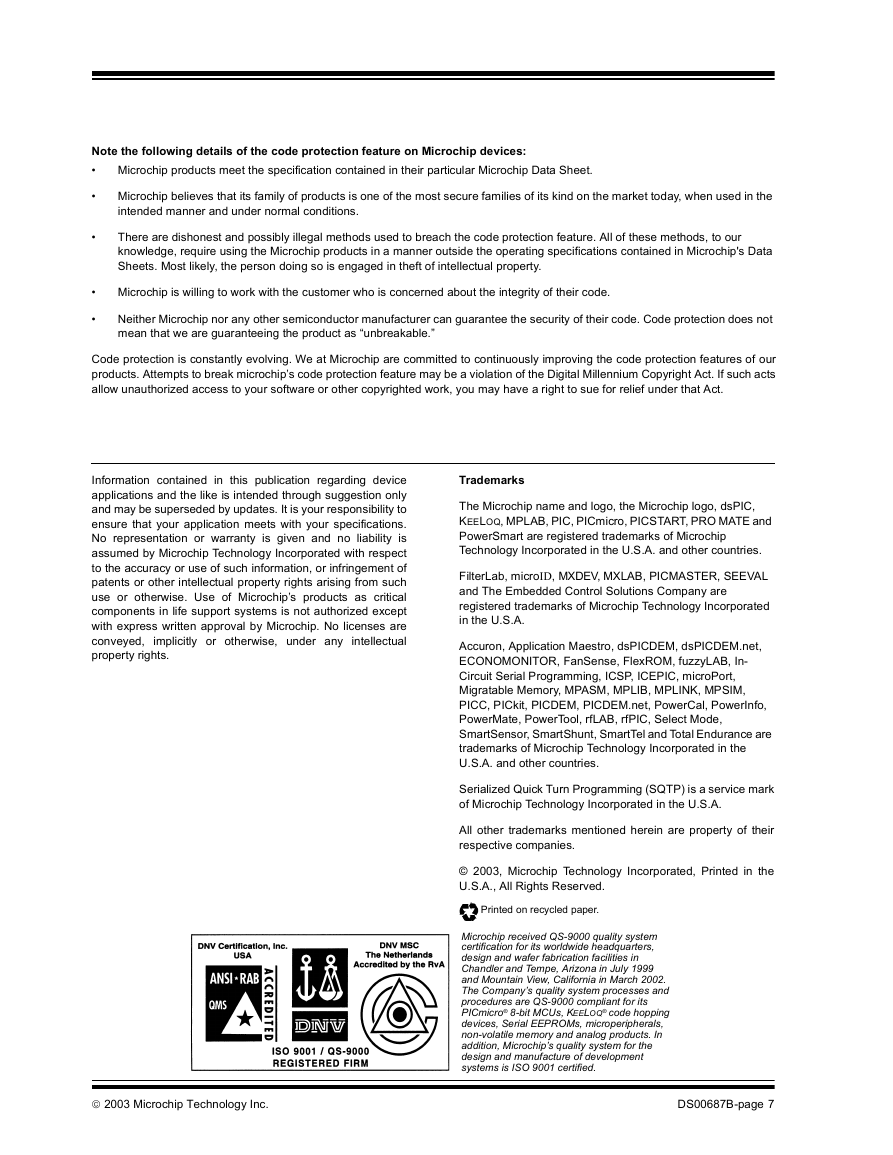
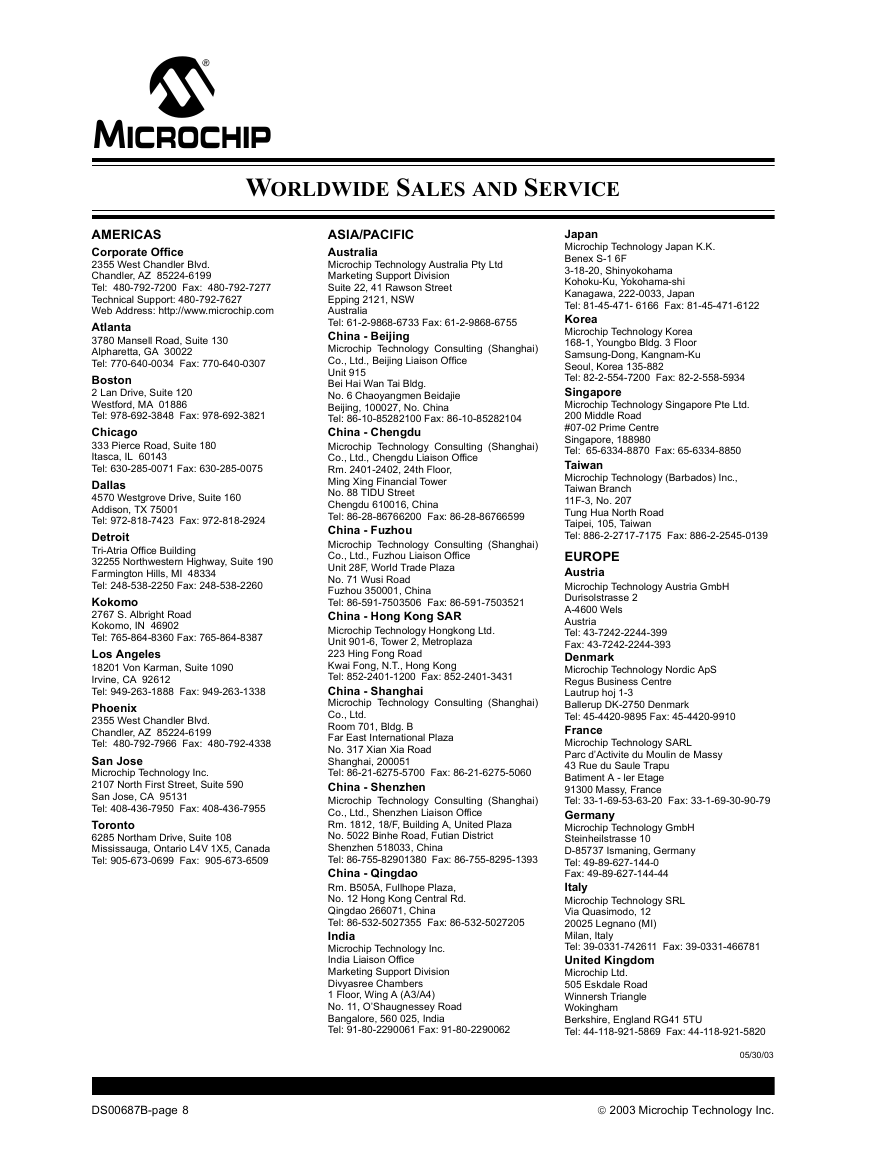








 2023年江西萍乡中考道德与法治真题及答案.doc
2023年江西萍乡中考道德与法治真题及答案.doc 2012年重庆南川中考生物真题及答案.doc
2012年重庆南川中考生物真题及答案.doc 2013年江西师范大学地理学综合及文艺理论基础考研真题.doc
2013年江西师范大学地理学综合及文艺理论基础考研真题.doc 2020年四川甘孜小升初语文真题及答案I卷.doc
2020年四川甘孜小升初语文真题及答案I卷.doc 2020年注册岩土工程师专业基础考试真题及答案.doc
2020年注册岩土工程师专业基础考试真题及答案.doc 2023-2024学年福建省厦门市九年级上学期数学月考试题及答案.doc
2023-2024学年福建省厦门市九年级上学期数学月考试题及答案.doc 2021-2022学年辽宁省沈阳市大东区九年级上学期语文期末试题及答案.doc
2021-2022学年辽宁省沈阳市大东区九年级上学期语文期末试题及答案.doc 2022-2023学年北京东城区初三第一学期物理期末试卷及答案.doc
2022-2023学年北京东城区初三第一学期物理期末试卷及答案.doc 2018上半年江西教师资格初中地理学科知识与教学能力真题及答案.doc
2018上半年江西教师资格初中地理学科知识与教学能力真题及答案.doc 2012年河北国家公务员申论考试真题及答案-省级.doc
2012年河北国家公务员申论考试真题及答案-省级.doc 2020-2021学年江苏省扬州市江都区邵樊片九年级上学期数学第一次质量检测试题及答案.doc
2020-2021学年江苏省扬州市江都区邵樊片九年级上学期数学第一次质量检测试题及答案.doc 2022下半年黑龙江教师资格证中学综合素质真题及答案.doc
2022下半年黑龙江教师资格证中学综合素质真题及答案.doc